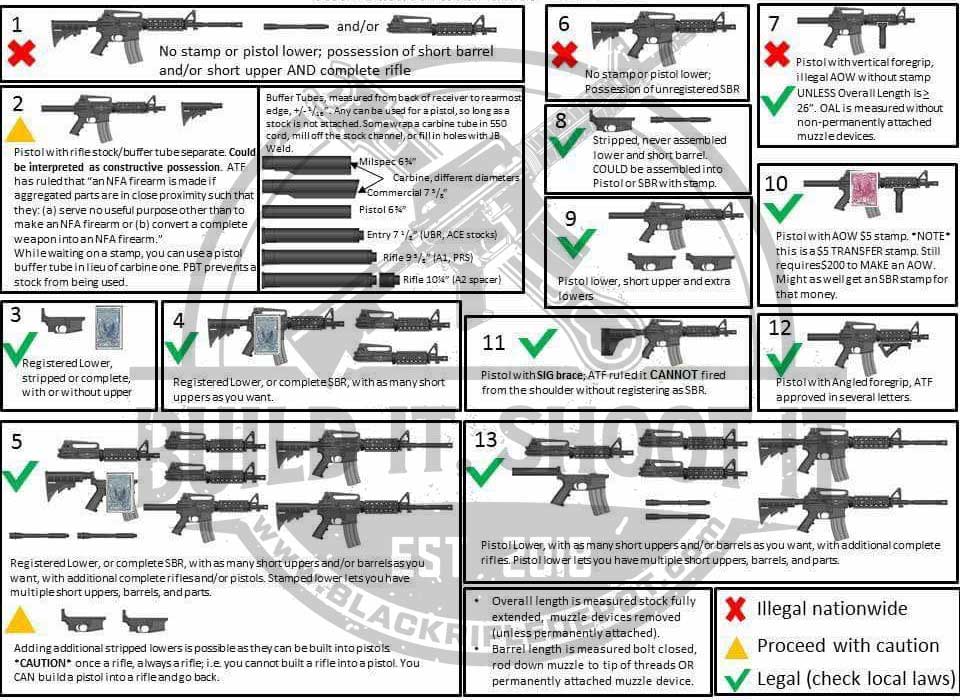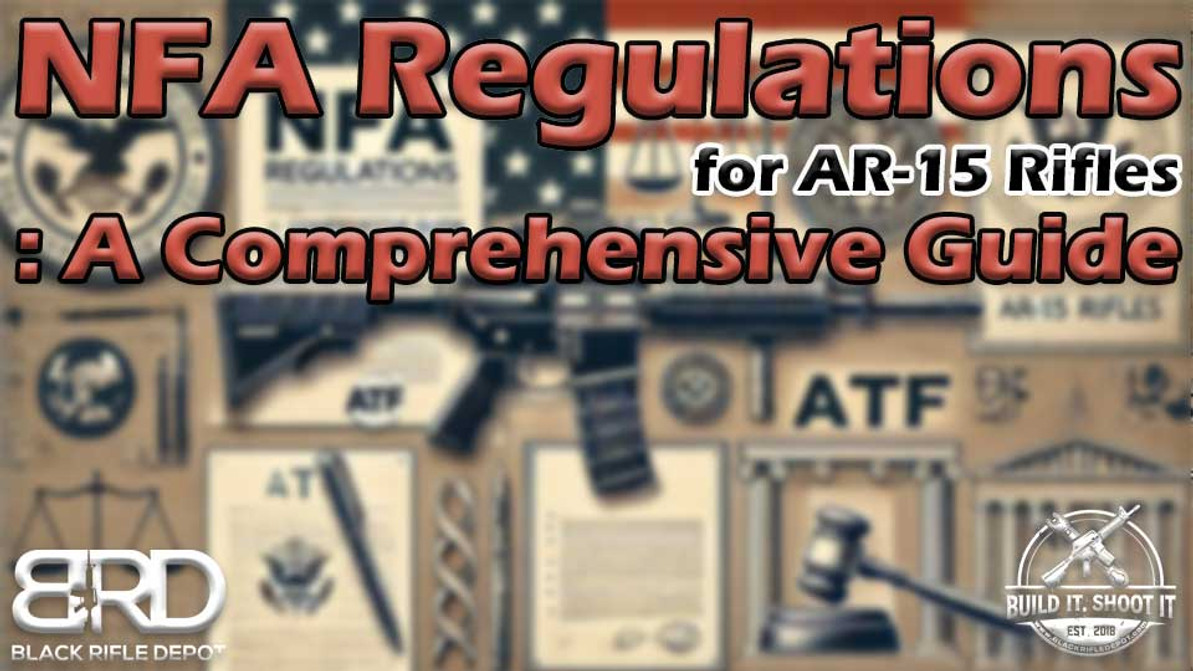NFA Regulations for AR-15 Rifles: A Comprehensive Guide
Navigating the complexities of NFA regulations is crucial for AR-15 owners to ensure their firearms comply with federal laws. The National Firearms Act (NFA) has specific rules that dictate how AR-15 rifles are classified, modified, and owned. Understanding these regulations is essential to avoid legal pitfalls and enjoy your AR-15 responsibly. Awareness of the consequences of non-compliance is vital to responsible ownership.
In this comprehensive guide, we’ll start by introducing NFA regulations, shedding light on the history and purpose of the NFA. Next, we’ll delve into AR-15 classifications under the NFA, explaining the nuances distinguishing standard AR-15s from NFA items. We’ll then outline steps for NFA compliance for AR-15 owners, detailing the necessary paperwork and procedures. To underscore the importance of compliance, we’ll discuss the legal implications and penalties associated with non-compliance. Finally, we’ll explore modifying your AR-15 under NFA guidelines, offering practical advice on legal modifications that you can implement to ensure compliance.
As you know, this guide is for informational purposes only and does not constitute legal advice. Please consult a qualified legal professional to address your circumstances and ensure you follow all applicable laws and regulations.

Introduction to NFA Regulations
The National Firearms Act (NFA) is a pivotal piece of legislation in the United States that regulates specific categories of firearms, including those with features commonly found in AR-15 rifles. Enacted in 1934, the NFA aims to control the ownership and distribution of particular types of weapons, such as short-barreled rifles (SBRs), suppressors, and fully automatic weapons. For AR-15 enthusiasts, understanding NFA regulations is crucial, especially when dealing with AR-15 uppers and other AR-15 parts that can impact the classification of your firearm.
The NFA requires the registration of certain firearms with the Bureau of Alcohol, Tobacco, Firearms, and Explosives (ATF) and imposes a tax on the manufacture and transfer of these firearms. Regarding AR-15 rifles, modifications can easily transition a standard rifle into an NFA-regulated item. For instance, installing an AR-15 complete upper with a barrel length shorter than 16 inches can reclassify your rifle as an SBR, necessitating compliance with NFA rules.
Understanding the history and purpose of the NFA helps AR-15 owners navigate the legal landscape, ensuring their builds remain compliant. Whether customizing your AR-15 with various AR-15 parts or considering significant modifications, being well-versed in NFA regulations is essential to avoid legal issues and enjoy your firearm responsibly. This knowledge is the foundation upon which AR-15 enthusiasts can build and modify their rifles within the bounds of the law.
AR-15 Classifications Under the NFA
Regarding the National Firearms Act (NFA), understanding how AR-15 rifles are classified is essential for compliance. The AR-15 is a highly customizable platform, and certain modifications can shift its classification under the NFA, impacting the legality of your firearm.

(NFA classifications constantly change, so this is a guide only and should not be used as legal advice.)
One of the primary distinctions made by the NFA is between standard rifles and short-barreled rifles (SBRs). An AR-15 with a barrel length shorter than 16 inches is classified as an SBR. This designation requires registration with the Bureau of Alcohol, Tobacco, Firearms, and Explosives (ATF) and a tax stamp. Additionally, the rifle's overall length plays a crucial role; if it falls below 26 inches, it further solidifies its status as an NFA item.
Other components, such as suppressors and fully automatic sears, can also reclassify an AR-15. Installing a suppressor on your AR-15 involves NFA regulations and necessitates the proper paperwork and tax stamp. Likewise, converting an AR-15 to fully automatic requires compliance with stringent NFA rules.
Even AR-15 uppers and other AR-15 parts can influence the classification. For example, possessing an upper receiver with a barrel shorter than 16 inches without a registered SBR can lead to legal complications. This is because the ATF considers the combination of parts that can easily be assembled into an NFA-regulated firearm to be constructive possession.
Understanding these classifications helps AR-15 owners make informed decisions about their builds. Ensuring that modifications comply with NFA guidelines is crucial to avoid severe penalties, including fines and imprisonment. By staying informed about AR-15 classifications under the NFA, enthusiasts can enjoy customizing their rifles while remaining within the bounds of the law.
NFA Compliance for AR-15 Owners
Ensuring NFA compliance for AR-15 owners is essential for legal and responsible firearm ownership. The National Firearms Act (NFA) imposes stringent regulations on specific firearm configurations, and understanding these requirements is crucial. For AR-15 owners, compliance often begins with proper classification. Under the NFA, AR-15 rifles with AR-15 barrels shorter than 16 inches or an overall length under 26 inches are classified as short-barreled rifles (SBRs), requiring registration with the Bureau of Alcohol, Tobacco, Firearms, and Explosives (ATF) and payment of a tax stamp.
The compliance process involves several steps. First, owners must complete and submit ATF Form 1 (for making an NFA firearm) or ATF Form 4 (for transferring an NFA firearm) along with the required fingerprint cards, photographs, and the $200 tax payment. After submission, applicants must have a thorough background check, if possible. The firearm can be legally assembled or transferred only after receiving approval from the ATF.
Maintaining compliance extends beyond initial registration. Owners must retain their approved paperwork and be prepared to present it to law enforcement upon request. Any modifications to the firearm must adhere to NFA regulations, and transferring the firearm requires repeating the compliance process.
Proper adherence to NFA guidelines helps AR-15 owners avoid severe penalties, including fines and imprisonment, while responsibly enjoying their firearms. By staying informed and following these steps, AR-15 enthusiasts can ensure their builds comply with federal laws.
Legal Implications and Penalties

Understanding the legal implications and penalties of NFA violations is critical for AR-15 owners. The National Firearms Act (NFA) imposes stringent regulations on specific firearm configurations, and failure to comply with these regulations can result in severe consequences. Non-compliance with the NFA can lead to significant legal penalties, including fines and imprisonment. Possessing an unregistered NFA firearm, such as an AR-15 classified as a short-barreled rifle (SBR) without the appropriate tax stamp and registration, is a federal offense. Conviction for such a violation can result in fines of up to $250,000 and imprisonment for up to 10 years. Additionally, violators may face forfeiture of their firearms and the potential for permanent loss of firearm ownership rights.
It's also important to note that constructive possession, or possessing parts that can be readily assembled into an NFA-regulated firearm, is considered a violation. For instance, owning an AR-15 rifle upper with a barrel shorter than 16 inches without a registered SBR can lead to legal trouble.
Furthermore, transferring an NFA firearm without the proper paperwork and approval from the Bureau of Alcohol, Tobacco, Firearms, and Explosives (ATF) is illegal and can result in similar penalties. Ensuring all transfers are conducted through the proper legal channels is essential to remain compliant.
Adhering to NFA regulations helps avoid these severe penalties and promotes responsible firearm ownership. Staying informed about the legal requirements and maintaining meticulous records can safeguard AR-15 owners from inadvertent violations and ensure their firearms are legally compliant.
Modifying Your AR-15 Under NFA Guidelines
Modifying your AR-15 under NFA guidelines requires careful adherence to regulations to ensure compliance and avoid legal repercussions. The National Firearms Act (NFA) regulates certain modifications that can reclassify an AR-15 as a short-barreled rifle (SBR), among other classifications. Here are several examples of changes and how to navigate them within NFA guidelines:
- Short-Barreled Rifles (SBRs): If you intend to install an AR-15 rifle upper with a barrel shorter than 16 inches, you must first register the firearm as an SBR with the Bureau of Alcohol, Tobacco, Firearms, and Explosives (ATF). This process involves submitting ATF Form 1, fingerprints, photographs, and a $200 tax payment. Only after receiving approval can you legally assemble the SBR.
- Suppressors: Adding a suppressor to your AR-15 requires compliance with NFA regulations. You must submit ATF Form 4 for the suppressor transfer, pay the $200 tax, and await approval. Possessing an unregistered suppressor can result in severe legal penalties.
- Fully Automatic Conversions: Converting an AR-15 to fully automatic operation is heavily regulated. This modification requires a registered drop-in auto sear (DIAS) or a registered lightning link, which must be NFA-compliant. Obtaining these components involves a thorough background check and the $200 tax stamp, and only pre-1986 machine guns are transferable to civilians.
- Constructive Possession: Be aware of constructive possession laws. Owning an unregistered AR-15 pistol upper along with a standard AR-15 lower can be considered illegal if the parts can be easily assembled into an NFA-regulated firearm. Always ensure your parts comply and avoid possessing components that could lead to unintentional violations.
- Additional Accessories: Certain accessories, like vertical foregrips on pistols, can reclassify your AR-15 as an AOW (Any Other Weapon) under the NFA. Could you ensure you understand the regulations for these accessories and comply with the necessary registration and tax requirements?
By meticulously following NFA guidelines and understanding the implications of each modification, AR-15 owners can legally customize their firearms while avoiding severe penalties. Proper documentation, adherence to legal processes, and thorough knowledge of NFA regulations are essential for responsible and lawful firearm ownership. 4o
Final Thoughts on NFA Compliance for AR-15 Owners
Navigating NFA regulations is essential for any AR-15 owner looking to customize their firearm while staying within the bounds of the law. Understanding the intricacies of the National Firearms Act (NFA) can help prevent legal issues and ensure responsible ownership. Compliance is critical, from proper classification and registration of short-barreled rifles (SBRs) to understanding the requirements for suppressors and fully automatic conversions.
Ensuring that all paperwork is correctly filed with the Bureau of Alcohol, Tobacco, Firearms, and Explosives (ATF) and maintaining meticulous records are fundamental steps in this process. Awareness of the legal implications and penalties associated with non-compliance, such as fines and imprisonment, underscores the importance of adhering to NFA guidelines.
When modifying your AR-15, it's crucial to understand how different parts and accessories affect its classification under the NFA. By staying informed and following the legal procedures, AR-15 owners can enjoy their firearms while remaining compliant with federal laws.
In conclusion, responsible AR-15 ownership under the NFA requires a thorough understanding of the regulations and a commitment to compliance. This guide provides a comprehensive overview of NFA regulations, classifications, compliance steps, legal implications, and modification guidelines. By adhering to these principles, AR-15 enthusiasts can enjoy their firearms safely and legally.
Recent Posts
-
Best AR-15 Handguards - MOE SL Handguard
In the world of AR-15 customization, handguards not only protect the barrel but are pivotal in enhan …Feb 5th 2025 -
Budget vs. Premium AR-15 Rifle Scopes: Are Expensive Optics Worth It?
When it comes to enhancing your AR-15's performance, selecting the right AR-15 rifle scope is crucia …Feb 2nd 2025 -
Top Lightweight Red Dot Sights for Minimalist AR-15 Builds
Choosing the right red dot sight for your AR-15 is more than just picking a well-known brand—i …Jan 30th 2025




